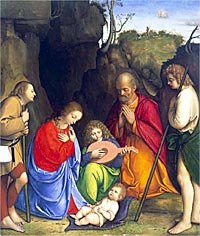Renaissance Paintings
In the middle age period between thirteenth and sixteenth century, Renaissance paintings dominated the art scene. These paintings reflected themes of religious inspiration and quest to understand God. The environment, saints, and heaven were visualized in religious, law, and medicine themes.
Generally, the interest of these artists was to paint astronomy, biology, natural world and science in the most captivating ways possible. Thus, this research paper attempts to evaluate symbolism, styles, material used, meaning, and aesthetic values of two outstanding paintings as a comparison and contrast of another. In addition, the treatise classifies these paintings into their respective classes, dimensionality, nature, message, and traditional functions.
The paintings identified for this analysis are the Madonna and Child in Glory by Jacopa di Cione in the period between 1360 and 1365, and the Adoration of the Shepherds by Giovanni Agostino da Lori in 1510. The Madonna and child in Glory panting is a landscape painting.
Jacopa has successfully painted this picture of the mother in a three dimensional form. Within its frame, it is clear that the saints are standing before Madonna, and the angels behind her. With the available mathematical formulas, Jacopa uses this tool to represent a convincing three dimensional space giving an impression of the painting frame being a window frame.
Interestingly, the first impression on looking into the painting is the same as that of gazing through a window (Catholic Museum, 2009). Since Madonna and Child in Glory painting was done in the 13th century when egg tempera was the most common material, Jacopa’s painting consists of egg tempera on a golden panel (The Guardian, 2009).
The egg tempera is casted on golden panel. The colors used include blue, yellow, gold, orange, cream, grey, and red mixed. The central image is that of Madonna holding her baby and is larger than the saints standing at Madonna’s feet or the angels on the upper edges.
Specifically, Jacopa made Madonna and her child the centre of attraction to enable viewers understand her significance and importance above others. The rough texture is properly merged with an array of soft and vibrant colors to make the final product look very real.
The rough texture is as a result of the quick drying nature of egg tempera. The subject matter of this painting is revelation of the religious significance of Madonna giving birth of Messiah. Madonna is surrounded by gold background symbolizing atmospheric value of heaven and beauty.
This art is representational of religious beliefs of the Catholic community who lived in this period. The hieratic painting conforms to Catholics ways of representing heavenly beings as larger than the ordinary men. Madonna’s rank is higher than that of the saints and angels (Sammuel, 2000). This painting displays the heavenly beauty in a rich atmosphere.
On the other hand, Adoration of the Shepherds painting by Giovanni Agostino da Lodi is also a three dimensional realistic painting done with more skills than the Madonna. The material used in this painting is oil spread on panel.
Unlike Jacopa’s piece of art, Agostina manages to present finer details of the images in his painting. The images are clear and the characters similar in size apart from the little baby. The technique of brush painting with a mixture of colors reveals an active aspect of imagery and inartistic realism.
A blend of soft and vibrant colors gives this painting a soft texture and refined composition. The translucent oil paint often dries slowly. This gave Agostina ample time to work on each layer of colors. In the end, the product appears deep and of greater dimension. A blend of green, yellow, grey, red, violet, and creamy colors makes the picture very attractive (Robin, 2007).
With the emergence of humanist ideology, Agostina is influenced to adopt the earthy theme of a green natural background as opposed to Jacopa’s heavenly golden background. The landscape and background of this painting presents an impression of forest, green gardens, and dwelling places of ordinary men (Michael, 2010).
This piece of art depicts two shepherds and an angel together with baby Jesus and his parents, Mary and Joseph. The angel is busy playing a lute in a natural green environment.
The green landscape is symbolic of these figures in the physical being and not heavenly world. The mood of this painting is happiness. Thus, this symbolizes the possibilities of living happy and full life on earth before transitional link to heaven. The perspective used in creating this painting presents a chronological sequence of color pigmentation on a specific landscape.
Agostina and Jacopa lived in the renaissance era. Their painting styles are more or less the same. This was later adopted by the modern academic arts (Adrian, 2000). These paintings present the relationship between humanity, universe and God. Simultaneously, classical precedent architecture has facilitated acceptance of these masterpieces and study.
These paintings are of extra ordinary quality representing the Catholic Church’s doctrines and beliefs. In conclusion, these paintings intrinsically influence views and nature of life in the world and heaven. Besides, posterity and simple oil and tempera on panel paintings communicates different artistic impressions within the same theme.

a.1 Madonna and Child in Glory by Jacopa di Cione (1360-1365).

a.2 Adoration of the Shepherds by Giovanni Agostino da Lori (1510).
References
Adrian, F. (2000). Artist of the Italian Renaissance. In Chronology part one(500-1350). Web.
Michael, D. (2010). Madonna and Child. In Artlex art dictionary modules. Web.
Robin, N. (2007). Key Innovations and Artists of the Italian Renaissance. In Eyecon Art. Web.
Sammuel, K. (2000). Humanism in the Renaissance. In the Renaissnce Connection. Web.
The Guardian. (2009). Why can’t scientists date the Portland Vase? In The Guardian(newspaper). Web.
Vatican Museum. (2009). Borghase Gallary. In Vatican Museum. Web.